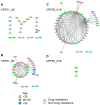HIV-1 Drug Resistance and Genetic Transmission Networks Among MSM Failing Antiretroviral Therapy in South China 2014-2019
- PMID: 34377002
- PMCID: PMC8349545
- DOI: 10.2147/IDR.S317187
HIV-1 Drug Resistance and Genetic Transmission Networks Among MSM Failing Antiretroviral Therapy in South China 2014-2019
Abstract
Background: Guangdong, located in South China, is one of the areas heavily affected by HIV-1 in China. The transmission of HIV-1 among men who have sex with men (MSM) has gradually been increasing in Guangdong.
Objective: To investigate the characteristics of the HIV-1 drug resistance, and genetic transmission networks in MSM with antiretroviral therapy (ART) failure from 2014 to 2019 in Guangdong.
Methods: HIV-1 pol gene sequences were amplified. An online subtyping tool was used to determine the genotype, and a maximum likelihood phylogenetic tree was reconstructed to confirm the genotype results. The Stanford University HIV Drug Resistance Database was used to analyse the sequences of drug resistance mutations (DRMs) and drug resistance profiles. A pairwise Tamura-Nei 93 genetic distance-based method was used to analyse the genetic transmission networks.
Results: Of 393 sequences isolated from HIV-infected MSM with ART failure, CRF01_AE (47.3%), CRF07_BC (21.4%) and CRF55_01B (21.4%) were the top three strains. 55.2% individuals harboured NRTI DRMs, whereas 67.4% carried NNRTI DRMs. 96.8% cases harboured mutations resistance to NRTIs or NNRTIs at high-level. The most common DRMs were M184I/V (42.2%), followed by V179D/E (37.9%) and K65R (27.2%). Of the subtype B sequences, no sequence fell into a cluster. Of the CRF01_AE, CRF55_01B, and CRF59_01B sequences, 14.5%, 61.9%, and 33.3% fell into clusters, respectively. Of the CRF07_BC sequences, 39.3% fell into clusters. The majority of MSM in transmission networks were concentrated at age below 35 years old, with multiple links. Moreover, approximately 54.8% of MSM had more than 2 potential transmission partners.
Conclusion: Drug resistance mutations more frequently occurred in NNRTIs among MSM with ART failure in Guangdong Province. Transmission network analysis revealed a complex transmission pattern, and more attention should be given to younger HIV-1-infected MSM with multiple links.
Keywords: HIV-1; MSM; drug resistance; genetic transmission networks.
© 2021 Lan et al.
Conflict of interest statement
The authors declare no conflicts of interest for this work.
Figures


Similar articles
-
Analysis of genotype resistance and HIV-1 transmission risk in HIV-1-infected men who have sex with men in Guiyang, China.Immun Inflamm Dis. 2024 Nov;12(11):e70029. doi: 10.1002/iid3.70029. Immun Inflamm Dis. 2024. PMID: 39552198 Free PMC article.
-
HIV-1 subtype diversity, drug resistance, and genetic transmission networks in men who have sex with men with virologic failure in antiretroviral therapy in Sichuan, China, 2011 to 2017.Medicine (Baltimore). 2019 Oct;98(43):e17585. doi: 10.1097/MD.0000000000017585. Medicine (Baltimore). 2019. PMID: 31651864 Free PMC article.
-
Drug resistance and genetic transmission characteristics of HIV-1 CRF59_01B in infected patients in Guangdong Province, China.J Antimicrob Chemother. 2022 Jun 29;77(7):1960-1968. doi: 10.1093/jac/dkac132. J Antimicrob Chemother. 2022. PMID: 35484082
-
HIV-1 genetic transmission networks among men who have sex with men in Kunming, China.PLoS One. 2018 Apr 26;13(4):e0196548. doi: 10.1371/journal.pone.0196548. eCollection 2018. PLoS One. 2018. PMID: 29698467 Free PMC article.
-
Characteristics of HIV-1 molecular transmission networks and drug resistance among men who have sex with men in Tianjin, China (2014-2018).Virol J. 2020 Nov 3;17(1):169. doi: 10.1186/s12985-020-01441-8. Virol J. 2020. PMID: 33143744 Free PMC article.
Cited by
-
Presence of the M184I mutation after short-term exposure to azvudine for COVID-19 in people living with HIV.AIDS. 2023 Jul 1;37(8):1341-1342. doi: 10.1097/QAD.0000000000003564. AIDS. 2023. PMID: 37930315 Free PMC article. No abstract available.
-
A systematic review and meta-analysis of HIV transmission risk behaviors, genetic variations, and antiretroviral (ARV) resistance in LGBT populations.J Public Health Res. 2024 Apr 14;13(2):22799036241239464. doi: 10.1177/22799036241239464. eCollection 2024 Apr. J Public Health Res. 2024. PMID: 38628579 Free PMC article.
-
Molecular network analysis for detecting HIV transmission clusters: insights and implications.Front Public Health. 2025 Jan 29;13:1429464. doi: 10.3389/fpubh.2025.1429464. eCollection 2025. Front Public Health. 2025. PMID: 39944061 Free PMC article.
-
Biophysical Characterization of Novel DNA Aptamers against K103N/Y181C Double Mutant HIV-1 Reverse Transcriptase.Molecules. 2022 Jan 3;27(1):285. doi: 10.3390/molecules27010285. Molecules. 2022. PMID: 35011517 Free PMC article.
-
The origin and dissemination of HIV-1 subtype B on Hainan Island, South China, 2007-2024.BMC Infect Dis. 2025 Mar 4;25(1):310. doi: 10.1186/s12879-025-10703-1. BMC Infect Dis. 2025. PMID: 40038615 Free PMC article.
References
-
- NCAIDS N, China CDC. Update on the AIDS/STD epidemic in China in August, 2018. Chin J AIDS STD. 2018;24:965. doi:10.13419/j.cnki.aids.2018.10.01 - DOI
-
- Hingankar NK, Thorat SR, Deshpande A, et al. Initial virologic response and HIV drug resistance among HIV-infected individuals initiating firstline antiretroviral therapy at 2 clinics in Chennai and Mumbai, India. Clin Infect Dis. 2012;54(suppl_4):S348–54. doi:10.1093/cid/cis005 - DOI - PMC - PubMed
LinkOut - more resources
Full Text Sources

